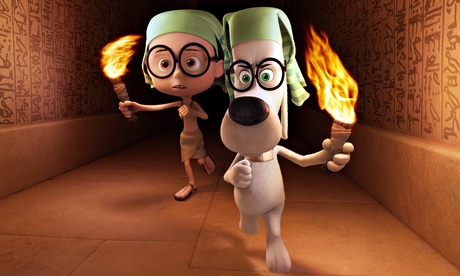
Cartoons with a conscience and a mission to educate have become the route to success in Hollywood this spring, after a winter devoted to greed and crime in films such as The Wolf of Wall Street and American Hustle.
Last week Mr Peabody & Sherman – a DreamWorks animation about a dog that adopts a child and travels through history encountering Marie Antoinette, Leonardo da Vinci and the Trojan horse – beat all-comers to top the US box office. Early next month 20th Century Fox's Rio 2, in which a lovable blue parrot and his friends battle extinction, is being rolled out in conjunction with a campaign by the US Forest Service to encourage children to spend more time outdoors and reconnect with nature.
Studio-sponsored, public-service announcements are planned in the hope of instilling a love for nature in children and creating a legacy of environmental stewardship.
The service says that more than 245 million Americans live within 100 miles of a national forest or grassland, yet people aren't taking advantage of these natural spaces. An app, discovertheforest.org, helps parents and children find the open spaces that 88% of children say they enjoy, according to one study.
Later this year Rihanna will be the voice of a character from DreamWorks' 3D computer-animated buddy comedy Home, based on the book The True Meaning of Smekday. The movie tells the story of an invasion of aliens and the relocation of humans to reservation land in Arizona. The comparison between Native Americans and the arrival of white settlers is more than just implied – a Navajo named Frank is depicted as the sole voice of reason.
But the insertion of environmental and multicultural messaging into animated films has less to do with Hollywood preaching than the execution of good business practice. The audience for animated film is broad, far broader than action adventure, and since James Cameron's eco-laden Avatar (still the highest grossing film of all time) and the superb Pixar hit Wall-E that addressed consumerism, environmental issues and the immense impact humans are having on this planet, film-makers have been comfortable addressing social issues they might shun in other genres.
"It's not necessarily new," says Deadline Hollywood's Dominic Patten, pointing to the success of last year's Epic, from Fox, and DreamWorks' The Croods, both of which had strong environmental themes.
"This has been true of animated films for many, many years," says Patten, though people often fail to grasp several important facts about animated film. "They're not for kids any more – parents and children only make up 50% of the box office. In fact, The Simpsons introduced the idea of social and satirical complexity years ago, and that's part of what we're now seeing in film."
Animated films, he says, also tend to make boatloads of money. Frozen not only made a billion dollars but its soundtrack sat at No 1 for weeks. Last week Disney CEO Bob Iger confirmed that Frozen would surpass the $1.06bn box-office takings of Toy Story 3.
Third, he says animated films are the only globalised cinematic genre and have a vast reach across many markets. But it's not about getting on a soapbox. "It's about talking about issues we know are important to people out there, as well as issues that are part of our world. If we find a way to tell more universally themed stories, film-makers can connect with audiences in stronger ways. That's what animated film can do: tell good, strong stories to everyone."
The Simpsons creator Matt Groening, arguably father of the genre, now sponsors a chair at UCLA's School of Theatre, Film and Television that gives out awards and financing to animators who highlight social responsibility in their submissions.
"It has to do with recognising the power of the moving image in the 21st century," says Barbara Boyle, associate dean of the school. "Animators have been including social responsibility for decades. Now they're getting to be more important. Animators can do anything. They're not limited. It's a true art form. You can have animals speak. You have no boundaries to reality so it allows boundless creativity. If you're learning about human issues, it doesn't matter if it's a rabbit talking to you …"

